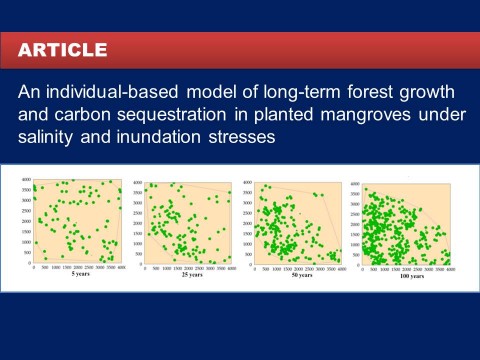Mangrove restoration study co-authored by OML Center Research Fellow, Dr. Juanico, now available online

Mainstreaming DRR into Land Use Planning for a Climate-Resilient Quezon City
December 11, 2016
Call for Applications: 4th International Workshop on Psychological Intervention After Disasters
December 11, 2016Mangrove restoration study co-authored by OML Center Research Fellow, Dr. Juanico, now available online

Ecosystem services provided by mangroves continue to gain attention from researchers and policy-makers alike as climate-related hazards intensify – threatening human survival and quality of life. In a study entitled “An individual-based model of long-term forest growth and carbon sequestration in planted mangroves under salinity and inundation stresses”, OML Center Research Fellow, Dr. Dranreb Earl Juanico, together with Dr. Severino Salmo of Ateneo de Manila University explores the climate regulation capacity of these botanical amphibians under the effects of salinity and tide (that have been found to be main stressors that constrain the growth and survival of planted mangroves) over a period equivalent to 100 years using a model – modified to suit Philippine environmental conditions – to bypass the challenges of time for the construction of a platform that has now made the assessment of future and ongoing local mangrove restoration programs possible.
Results have been found to be consistent with field observations and, therefore, expected; these include the sporadic to congregated distribution of mature trees in a period of five to a hundred years at the optimal (where stressors are absent) and the suggestion of trajectories that “the density of mature trees rapidly increases within a very short time.” In addition, biomass and carbon stocks have been found to be low – accounted for by the low diversity of the restored system. What the researchers found to be striking, however, was the “sudden collapse of the mangrove population at 50 years post planting particularly under the most extreme sub-optimal conditions.”
This leaves the study with the following conclusions: 1) the amount and rates of carbon sequestered by typical mangrove restoration efforts are likely to be very low and 2) there is a possibility that the planted mangroves may perish in the long run. With these, the authors emphasize “the importance of the appropriateness of the planting site in terms of the levels of salinity and inundation stresses” and, in a way, compel stakeholders to rely more heavily on proactive measures that protect the diverse, natural, and existing structures post-disaster rather than on the reactive, for which calamities set the agenda.
Gathered insights have been invaluable despite sited limitations and among those that deserve acknowledgement is the Commission on Higher Education (CHED) – Philippine Higher Education Research Network (PHERNet) for funding the study. It was presented at the PAMS 12 conference in Tacloban City in October 2013 and has now been made available online by the International Journal of Philippine Science and Technology (formerly Philippine Science Letters).
See the full manuscript through this link.
